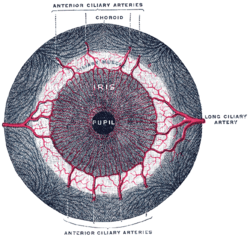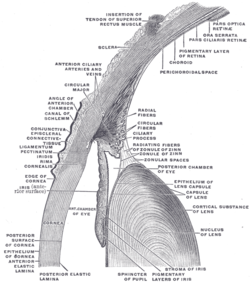Theiris sphincter muscle(pupillary sphincter,pupillary constrictor,circular muscle of iris,circular fibers) is amusclein the part of theeyecalled theiris.It encircles thepupilof the iris, appropriate to its function as a constrictor of the pupil.
| Iris sphincter muscle | |
|---|---|
 Iris,front view. (Muscle visible but not labeled.) | |
 The upper half of a sagittal section through the front of theeyeball.( "Sphincter of pupil" labeled near bottom-center.) | |
| Details | |
| Origin | Encircles iris[1] |
| Insertion | Encircles iris[1] |
| Artery | Long posterior ciliary arteries |
| Nerve | Short ciliary nerves |
| Actions | Constrictspupil |
| Antagonist | Iris dilator muscle |
| Identifiers | |
| Latin | musculus sphincter pupillae |
| TA98 | A15.2.03.029 |
| TA2 | 6762 |
| FMA | 49157 |
| Anatomical terms of muscle | |
Theciliary muscle,pupillary sphincter muscleandpupillary dilator musclesometimes are calledintrinsic ocular muscles[2]orintraocular muscles.[3]
Comparative anatomy
editThis structure is found invertebratesand in somecephalopods.[citation needed]
General structure
editAll themyocytesare of thesmooth muscletype.[4]
Its dimensions are about 0.75 mm wide by 0.15 mm thick.[citation needed]
Mode of action
editIn humans, it functions to constrict thepupilin bright light (pupillary light reflex) or duringaccommodation.[citation needed]In lower animals, the muscle cells themselves are photosensitive causing iris action without brain input.[5]
Innervation
editIt is controlled byparasympatheticpostganglionic fibers releasing acetylcholine acting primarily on themuscarinic acetylcholine receptor(M3) of iris sphincter muscle.[6]Preganglionic fibers originate from theEdinger–Westphal nucleus,travel along theoculomotor nerve(CN III), and make nicotinic cholinergic synapses on neurons in theciliary ganglion.[7]Those neurons' postganglionic parasympathetic fibers then enter the eye through theshort ciliary nerves.The short ciliary nerves then run forward and pierce thescleraat the back of the eye, traveling between the sclera and thechoroidto innervate the iris sphincter muscle.
See also
editReferences
edit- ^abGest, Thomas R; Burkel, William E. (2000)."Anatomy Tables - Eye".Medical Gross Anatomy.University of Michigan Medical School. Archived from the original on 2010-05-26..
- ^Kels, Barry D.; Grzybowski, Andrzej; Grant-Kels, Jane M. (March 2015). "Human ocular anatomy".Clinics in Dermatology.33(2):140–146.doi:10.1016/j.clindermatol.2014.10.006.PMID25704934.
- ^Ludwig, Parker E.; Aslam, Sanah; Czyz, Craig N. (2024)."Anatomy, Head and Neck: Eye Muscles".StatPearls.StatPearls Publishing.PMID29262013.
- ^Pilar, G; Nuñez, R; McLennan, I. S.; Meriney, S. D. (1987)."Muscarinic and nicotinic synaptic activation of the developing chicken iris".The Journal of Neuroscience.7(12):3813–26.doi:10.1523/JNEUROSCI.07-12-03813.1987.PMC6569112.PMID2826718.
- ^"Mouse eyes constrict to light without direct link to the brain".Phys.org.No. 19 June 2017.Retrieved20 June2017.
- ^Ishizaka, N; Noda, M; Yokoyama, S; Kawasaki, K; Yamamoto, M; Higashida, H (March 1998). "Muscarinic acetylcholine receptor subtypes in the human iris".Brain Res.787(2):344–7.doi:10.1016/s0006-8993(97)01554-0.PMID9518684.
- ^Berg, DK; Shoop, RD; Chang, KT; Cuevas, J (2000). "Nicotinic Acetylcholine Receptors in Ganglionic Transmission". In Clementi, F.; Fornasari, D; Gotti, C (eds.).Neuronal Nicotinic Receptors.Handbook of Experimental Pharmacology. Vol. 144.Springer.pp.247–67.ISBN978-3-642-63027-9.
External links
edit- Overview of function at tedmontgomery
- Slideat mscd.edu
- Histology image: 08010loa– Histology Learning System at Boston University